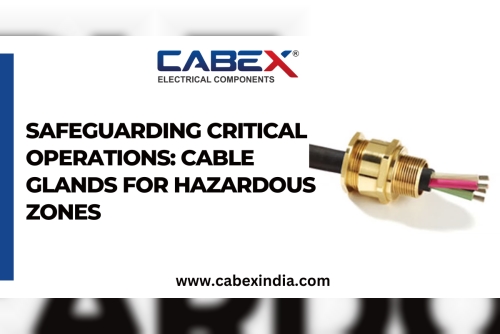Introduction
Hazardous environments, where flammable gases, vapors, dust, or liquids may be present, require stringent safety measures, particularly when it comes to electrical installations. Cable glands hazardous area play a critical role in ensuring the safety and integrity of electrical systems in such locations. They provide a secure, sealed connection between electrical equipment and cables, protecting against the ingress of hazardous substances and maintaining system integrity.
This guide delves into the importance of cable glands for hazardous areas, their key features, types, and how to select the right cable gland for your specific application.
What Are Hazardous Areas?A hazardous area is any environment where there is a risk of fire or explosion due to the presence of flammable gases, vapors, liquids, dust, or fibers. Such areas are commonly found in industries like oil and gas, petrochemicals, pharmaceuticals, mining, and food processing. The potential for these substances to ignite when exposed to an electrical spark or high temperatures makes it crucial to install safety-rated equipment, including cable glands.
In hazardous areas, electrical components must meet strict safety standards to prevent accidents and protect both people and assets. This is where hazardous area cable glands come into play.
Why Are Cable Glands Important in Hazardous Areas?Cable glands in hazardous areas perform several critical functions:
1. Sealing and Protection: Cable glands provide a secure seal around the cable to prevent the entry of flammable gases, dust, or liquids into the equipment. This seal is essential in ensuring that the hazardous substances do not come into contact with live electrical connections, which could cause a spark and ignite an explosion.
2. Mechanical Protection: Cable glands offer mechanical support and strain relief, ensuring that cables are held firmly in place and protected from physical damage, such as pulling, twisting, or vibration, which can lead to exposed wires or electrical faults.
3. Compliance with Safety Standards: Cable glands used in hazardous areas must comply with international safety standards like ATEX (Europe) and IECEx (International). These certifications ensure that the glands are tested and approved for use in potentially explosive atmospheres.
Types of Cable Glands for Hazardous AreasThere are different types of cable glands specifically designed for hazardous areas, each with unique features to meet the needs of specific applications.
1. Explosion-Proof (Flameproof) Cable Glands (Exd)Explosion-proof or flameproof cable glands are designed to contain any internal explosion within the enclosure, preventing it from spreading to the outside atmosphere. These glands are typically used in Zone 1 (high risk) and Zone 2 (medium risk) hazardous areas.
Applications: Oil refineries, petrochemical plants, offshore platforms. Materials: Brass, nickel-plated brass, stainless steel. Key Feature: Contains any potential explosion within the cable enclosure. 2. Increased Safety (Exe) Cable GlandsIncreased safety cable glands are designed for use in hazardous areas where there is a lower risk of explosion, such as Zone 2 areas. They provide enhanced mechanical protection and sealing to prevent dust, water, and gas ingress.
Applications: Mining, chemical processing, food and beverage industries. Materials: Brass, stainless steel, polyamide. Key Feature: Offers enhanced sealing but does not need to contain an explosion. 3. Intrinsically Safe (Exi) Cable GlandsIntrinsically safe cable glands are used in systems where the electrical energy is kept low enough that it cannot cause ignition, even in the presence of flammable gases or dust. These glands are used with intrinsically safe equipment that operates on low-power circuits, ensuring no risk of sparks.
Applications: Pharmaceutical industries, grain silos, paint manufacturing. Materials: Brass, stainless steel. Key Feature: Prevents any ignition in low-power, inherently safe systems. 4. Dust-Ignition-Proof Cable GlandsDust-ignition-proof cable glands are used in areas where combustible dust presents a hazard. These glands ensure that dust does not enter the enclosure, preventing the risk of an explosion or fire.
Applications: Grain processing, cement plants, textile mills. Materials: Brass, stainless steel. Key Feature: Prevents dust from entering and igniting inside the electrical enclosure. Key Features of Cable Glands for Hazardous AreasCable glands designed for hazardous environments come with specific features to ensure they perform effectively under extreme conditions. These include:
1. Corrosion Resistance: Glands made from materials like stainless steel or nickel-plated brass offer excellent resistance to corrosion, which is crucial in environments like offshore oil rigs or chemical plants.
2. Ingress Protection (IP Rating): Cable glands for hazardous areas typically offer high ingress protection ratings, such as IP66, IP67, or IP68, ensuring they are protected against dust and water ingress.
3. Flameproof Design: In explosion-proof cable glands, the flameproof design ensures that any internal spark or explosion does not escape and ignite the surrounding atmosphere.
4. High-Temperature Resistance: These glands are designed to operate in extreme temperatures, both high and low, which is essential for industrial environments where temperature fluctuations are common.
5. Strain Relief and Cable Protection: Cable glands provide strain relief, protecting cables from mechanical stress, which is critical in areas with heavy machinery or continuous movement.
6. Certification: Hazardous area cable glands must carry relevant certifications like ATEX, IECEx, CSA, or UL to indicate they meet the necessary safety requirements for use in explosive atmospheres.
How to Choose the Right Cable Gland for Hazardous AreasSelecting the correct cable gland for a hazardous area involves considering several factors to ensure optimal performance and safety:
1. Zone Classification: Hazardous areas are classified into zones based on the likelihood of an explosive atmosphere being present. Cable glands should be chosen according to whether they will be used in Zone 0, Zone 1, or Zone 2 for gas or Zone 20, Zone 21, or Zone 22 for dust.
2. Cable Type: Determine whether you are using armored or unarmored cables. Explosion-proof cable glands are available for both types, but the gland must match the cable design to ensure a proper fit and sealing.
3. Material: The material of the gland should be selected based on the environmental conditions. Stainless steel is ideal for corrosive environments, while brass may be suitable for less aggressive conditions.
4. Ingress Protection: Ensure the gland has a suitable IP rating for protection against dust and water. For example, an IP68 rating is recommended for outdoor or submerged applications.
5. Temperature Range: Verify that the cable gland can operate within the temperature range of your application, especially in industries like oil and gas, where temperatures can be extreme.
6. Certification: Always select a gland with the relevant certifications (ATEX, IECEx, etc.) to ensure it meets safety standards for hazardous environments.
Frequently Asked Questions (FAQs)1. What are hazardous area cable glands?
Hazardous area cable glands are specially designed connectors that provide a safe, sealed connection for electrical cables in environments where explosive gases, vapors, or dust are present. They help prevent the risk of fire or explosion by ensuring that cables are properly sealed and protected.2. What is the difference between Exd and Exe cable glands?
Exd (explosion-proof) cable glands are designed to contain an internal explosion within the gland, preventing it from spreading to the surrounding atmosphere. Exe (increased safety) cable glands do not contain explosions but offer enhanced mechanical protection and sealing to prevent the ingress of hazardous substances.3. Which certifications should cable glands for hazardous areas have?
Cable glands for hazardous areas should have certifications such as ATEX, IECEx, UL, or CSA, which indicate they meet international safety standards for explosive atmospheres.4. How do I choose the right cable gland for a hazardous area?
To choose the right cable gland, consider factors like the zone classification of the hazardous area, the type of cable (armored or unarmored), the material of the gland (for corrosion resistance), the IP rating (for dust and water protection), and the operating temperature range.5. Can I use standard cable glands in hazardous areas?
No, standard cable glands are not suitable for hazardous areas. You must use hazardous area-certified cable glands that meet the necessary safety standards, such as ATEX or IECEx, to ensure safe operation in explosive environments. ConclusionCable glands for hazardous areas are essential components for ensuring the safety and reliability of electrical installations in explosive atmospheres. These glands offer protection against environmental hazards, prevent the ingress of harmful substances, and provide mechanical strength to cables. When selecting cable glands for hazardous areas, it is crucial to choose certified products that meet international safety standards and are suitable for the specific conditions of your environment. With the right cable glands, industries can safeguard their operations and reduce the risk of fire, explosion, or equipment failure.












